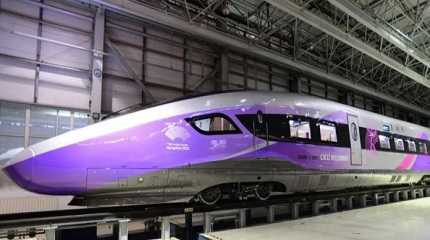
BEIJING, July 22 (APP): A Fuxing bullet train specially designed for the Hangzhou Asian Games rolled off the production line in Changchun, northeast China’s Jilin Province.
It will run between Hangzhou, the host city of the 19th Asian Games, and the five co-host cities of Ningbo, Wenzhou, Jinhua, Shaoxing, and Huzhou in east China’s Zhejiang Province during the event, CGTN reported on Saturday.
The Asian Games-themed Fuxing intelligent electric multiple unit (EMU) consists of eight cars with a capacity of 578 passengers and can reach a speed of 350 kilometers per hour.
It is coated in Rainbow Purple, a dominant color for the event, and decorated with patterns of the emblem, slogan, and sports pictograms.
Full 5G+Wi-Fi network coverage is offered on the EMU and intelligent interactive terminals are available in some carriages, which provide high-speed rail recreation, wireless screen projection, operation information, and other services for passengers during the journey.
To facilitate the travel of passengers with special needs, the train also has barrier-free carriages, which have been equipped with 90-centimeter-wide passage doors, barrier-free toilets and wheelchair storage areas.
Braille signs have been installed at multiple service points, such as seats, wheelchair storage areas and toilets, making it easy for visually impaired passengers to use.
The EMU has been optimized for an overall improved passenger experience.
Dozens of test runs have been conducted to improve its smooth operation, and the seats have been adjusted based on ergonomics.
An automatic air pressure and temperature adjustment system has been installed, which can effectively relieve the discomfort of tinnitus caused by changes in air pressure when passing through a tunnel.
The EMU’s locomotive has a bionic design, which will greatly reduce aerodynamic resistance and cut energy consumption by about 10 percent.
With lightweight vehicle body design and overall energy-saving technology, it can save about 1.8 million kWh of electricity annually, and the application of Ethernet technology will increase the data transmission speed in the train by more than 60 times.
A big data analysis platform will help operators monitor its performance and predict malfunctions.




